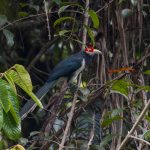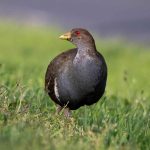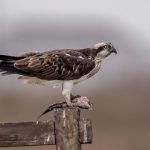Yesterday we posted about the tremendous variety of parrots found in Guyana, northern South America, and mentioned the work of Marc Johnson and Karen Windsor of Foster Parrots Ltd, who not only run a large wildlife sanctuary in Rhode Island, but are passionate about Guyana and promoting the country’s extraordinary bio-diversity to eco-tourists.
Today we’re posting a hard-hitting but very thoughtful interview with Karen, in which she talks about her love for parrots and the heart-breaking sight of the psychologically-damaged birds she and Marc take in. Karen lays the blame for so many disturbed and damaged parrots squarely on the pet trade, and talks passionately too about the effect seeing wild parrots flying around a rainforest has on her…
How did Foster Parrots and the New England Exotic Wildife Sanctuary come to be?
- KW: We had operated our parrot rescue and adoption organization for many years out of a house and a large renovated barn in Rockland, MA. and had outgrown our circumstances. Because of the number of parrots we had that were not candidates for adoption, and because we were seeing so many returns on parrots we would adopt out, we began to understand that there was an undeniable need for permanent care accommodations for large numbers of parrots that were not making it as pets. Our mission to find a suitable location for a large, permanent care facility and the funding to make it all happen began around 2002. It all finally came together in 2006 when we started working with Roy Dubs, a retired business entrepreneur with a lot of land in Rhode Island and a huge heart for helping animals.
I read on the Foster Parrots website that you became interested in parrots after buying one at a yard sale. Can you talk a little bit about how then you became involved in parrot rescue? Where do the rescued and foster birds come from?
- KW: They come from everywhere. They come from people who bought a bird on impulse without doing their homework. They come from people who thought they had done their homework, only to find that parrot guardianship was still much more than they had bargained for. They come from people who are forced to give up these treasured family members due to serious health issues, and they come from people who simply cast them aside when they’ve become inconvenient. We’ve rescued birds from breeders who have gone under or decided to quit the business. We’ve rescued them from basements and garages. We’ve stepped in many times in cases where healthy birds were scheduled to be euthanized (in cases like this it’s actually “killing” not “euthanizing”). We’ve even rescued large numbers of birds from other rescue organizations that have failed.
What species come in? Which are the most common? What’s the rarest bird that has turned up at the sanctuary?
- KW: All species come in! We get many surrender requests for small birds like budgerigars and cockatiels just because they are inexpensive, more easily and widely obtained, and are perhaps considered to be more “disposable” than some of the more expensive birds. Every species of conure come in. These are attractive in the pet trade, sometimes because people think they want to “take a step up” from the typical small “starter bird” without getting in too deep with one of the large parrot species. But conures are LOUD! And demanding. They require every bit as much time, creativity and management as their larger cousins.
One of the most frequent surrender requests we receive is from people seeking to unload their cockatoos. Cockatoos, especially the larger species (Moluccans, Umbrellas) have a reputation as being the most loving and affectionate of birds. This can be true. But that they can be needy beyond the means of any human to fulfill them adequately. And the flip side of cockatoos is – they can become extraordinarily aggressive and dangerous once they reach sexual maturity. They are also extraordinarily vocal and destructive! Cockatoos don’t stick in their homes.
 It’s hard to say what’s the rarest bird. We have taken in many sun conures over the years. These are stunningly beautiful little birds. They are LOUD. People don’t tolerate them well. There’s an abundance of them in captivity, but as it turns out, they are one of the rarest of birds in the wild, having been nearly wiped out by the pet trade.
It’s hard to say what’s the rarest bird. We have taken in many sun conures over the years. These are stunningly beautiful little birds. They are LOUD. People don’t tolerate them well. There’s an abundance of them in captivity, but as it turns out, they are one of the rarest of birds in the wild, having been nearly wiped out by the pet trade. We have a pair of Great Green macaw [photo left, copyright Foster Parrots Ltd], almost as rare in captivity as they are in the wild.
We have a Golden conure, a Blue Throated macaw and a Hyacinth. The Hyacinth is the least rare and endangered, but he’s the biggest and the bluest, so he’s much more expensive on the retail market than any of our more rare species. Go figure.
You must have seen some horrific things in your years working with rescued parrots. What’s that like? Does it make the job more difficult or does it give you more of an impetus to continue your work?

- KW: It makes the job more difficult and it gives us more impetus to continue. Our hearts get broken every single day. We cry a lot. There is so much tragedy out there. There is so much suffering. The best we can do is still never enough.
But every little victory is so incredibly meaningful. There is nothing more gratifying than receiving a parrot who has lived in fear and loneliness for 10 or 20 years, and transforming his life – giving him a partner to bond with, room to fly, toys to play with, healthy food…
We specialize in caring for birds who don’t like humans, have not been successful pets and have suffered in captivity because of their wild natures. Knowing that we have made all the difference in that individual life is what keeps us going.
I noticed that your website has a page called “know your sanctuary” that warns people to carefully check out a sanctuary’s practices before giving up their parrot. Are unethical sanctuaries a major issue?
- KW: Unethical sanctuaries are a huge issue. How can it possibly be ethical to rescue unwanted birds and solicit public funding for the care of the parrots you rescue, while supporting breeding and the production of more and more parrots? It’s an obvious conflict of interest, yet there are a lot of so-called rescue organizations out there that walk hand-in-hand with the breeding industry. This is no more acceptable than it would be to have an SPCA promoting a puppy mill. Only worse. Parrots are wild animals who make extraordinarily difficult and demanding companions. The likelihood of a parrot becoming an unwanted statistic is even greater than that of a dog. In fact, its difficulty as a “pet” coupled with its long life span pretty much guarantees that a parrot is, sooner or later, going to end up losing its home.
What would you consider a successful outcome for an individual bird that comes to the sanctuary?
- KW: When we talk about “rehabilitation”, we are not talking about making a bird a better “pet”. We are talking about helping birds be birds again, integrating them back into the society of birds. The best outcome we can hope for is to have a bird come in, find an appropriate avian partner and to live a completely fulfilled life in a flock situation.
 Sometimes birds come in who are just plain wild. All they ever wanted was an avian companion. Other birds need to be “weaned” from their dependence on humans. Cockatoos are a great example of this. They love people. But they pack a devastating bite, they destroy everything they can get their beaks around, their screams can be heard practically across town. They get rejected by people over and over and over again. When they come here, find a proper cockatoo partner who will always be by their side, get to fly, scream and chew as much as they like… well, that’s a successful outcome for that bird. He’s finally home.
Sometimes birds come in who are just plain wild. All they ever wanted was an avian companion. Other birds need to be “weaned” from their dependence on humans. Cockatoos are a great example of this. They love people. But they pack a devastating bite, they destroy everything they can get their beaks around, their screams can be heard practically across town. They get rejected by people over and over and over again. When they come here, find a proper cockatoo partner who will always be by their side, get to fly, scream and chew as much as they like… well, that’s a successful outcome for that bird. He’s finally home.
Do you put more blame for the excess of pet parrots on the trappers/smugglers, the breeders, the pet stores, the pet-owners or something else?
- KW: The blame rests squarely on the shoulders of the pet trade. Let’s face it – trappers/smugglers are just jumping on the opportunity to fulfill a demand. And parrot consumers are, more often than not, enticed into purchasing birds without the benefit of complete information. Breeders, pet stores and the over-all retail market are responsible for painting an attractive picture of parrot “ownership” that is geared toward generating parrot sales and perpetuating the retail market. Trade in parrots generates untold millions of dollars annually, not just in the sale of parrots, but in the merchandizing surrounding parrots. Cages, toys, cleaning products, health products, food…
The truth is, the small cages that are generally offered to consumers at an affordable price are inadequate and should be considered a form of abuse. The truth is that the vast majority of people who purchase a parrot as a pet are going to keep that bird in a socially isolated situation, rob it of its gift of flight, and eventually abandon their responsibility to that animal when any number of difficulties arise.
Is there any need at all for a parrot breeding industry?
- KW: I do not believe that parrots should be bred for lives in captivity. I do believe that breeding programs for release/re-population efforts to help sustain parrots in the wild are quite valuable. Especially as they pertain to endangered species like Blue Throated macaw, Golden Conures, Great greens, etc…
The avicultural sector likes to claim that breeding parrots for captivity is important to the conservation of threatened and endangered species. This is false. What you end up with are captive bred and raised birds that have no ability to live in the wild, and that ultimately will bear no genetic resemblance to their species. Captive breeding eliminates the process of natural selection that strengthens, perpetuates and maintains the integrity of a species.

Do you think parrots should be kept as pets at all?
- KW: I do not. I believe that parrots sacrifice more than any other domestically kept animal in order to be companions to people. I have parrots at home who I love with all my heart and soul. If I could give them back the lives they were meant to have, I would.
Foster Parrots has a wild parrot conservation project in the South American country of Guyana. When we go there and watch parrots flying free, it’s a deeply emotional experience. It gives one a new perspective.
Once you see a Scarlet [photo left, copyright Foster Parrots Ltd] or Green Wing macaw flying free in their home range, you understand how wrong it is to keep one in a cage.
What kind of laws protect parrots in the United States? Are they remotely adequate?
- KW: There are almost no laws to protect parrots in the U.S. There are no legal standards whatsoever to regulate the breeding industry. And by this I mean that there is no licensing required, there is no legal mandate for veterinary oversight to help stem the perpetuation of prevalent avian diseases like psittacosis, Psittacine Beak and Feather Disease or Pachecos disease that are all coming straight out of the breeding mills. There are no legal regulations for diet, cage size, opportunities for exercise, access to sunlight or cleanliness of environment. The industry is an unregulated free-for-all. And the vast majority of mass-production parrot breeding facilities are hell-holes for parrots.
Whenever any kind of legislation is proposed to help protect parrots in the market, the avicultural community and pet industry giants come out in force to ensure that aviculture remains regulation free. The sale of unweaned baby birds is a good example of this. Imagine! In 49 out of 50 states it is perfectly legal to ship and sell a baby bird that is not even able to eat to save its own life. California has been the only state so far to successfully get legislation passed to control the retail sale of unweaned baby birds. The industry fought this legislation with everything it had. Unfortunately, they were able to water down the original intent of the bill significantly. Unweaned babies can still be put into retail situations in California, provided pet store employees complete an on-line PIJAC ( Pet Industry Joint Advisory Committee) course in hand-feeding. Absolutely tragic. Parrots are highly intelligent, highly social animals that require an extended parental nurturing period in order to develop into well-adjusted, healthy adults. Parental deprivation, forced weaning and the sale of unweaned birds are traditional practices of the aviculture that help flood the market with an abundance of psychologically damaged and phobic birds that don’t stand a chance of developing into healthy, stable pets. They are born to fail, and to end up on the doorsteps of rescue and shelter organizations.
It’s interesting and important to note that professional parrot breeders generally stand quite vehemently against the sale of unweaned baby birds. But they will not support unweaned baby bird legislation.
Is it a constant battle to get funding/stay solvent?
- KW: Avian rescue is one of the most underfunded segments of the animal welfare world. The big national animal welfare organizations champion dog and cat issues and people are able to connect easily with dogs and cats. Parrots do not get the same kind of attention or support. We struggle constantly to bring awareness to the problem of unwanted parrots, and to finance lifetime care of the countless parrots we now provide for and will be faced with in the future that are simply unsuitable as pets due to the fact that they are, in every respect, wild animals. When we’re talking about lifetimes that can range between 25 and 95 years – that poses a serious financial dilemma.

The New England Exotic Wildife Sanctuary
| From “Know your sanctuary” page on Foster Parrots: “A sanctuary is a place of peace, comfort and safety for birds and animals. Many of the animals under our care now and in the future will have come from situations of neglect, abuse or exploitation at the hands of humans. Our goal is to accept birds and animals from harmful and/or stressful captive circumstances. To let them heal. To let them be the animals they were meant to be with companions of their own kind. Many rescued animals must overcome layers of fear. Parrots in particular often find it challenging to reconnect with their own species and to form natural relationships with other birds. By limiting human distraction and interaction we work to protect and encourage the process of assimilation. For this reason we hope that people can respect the sanctity of the mission, understanding that, while we do accept visitors by appointment, the NEEWS is not a public venue and its animals are not on exhibit.” |
What can our readers do to help?
- KW: Well, of course, we urge readers to support parrot rescue and sanctuary initiatives. Beyond that – refuse to support the retail trade in parrots. Don’t buy! Adopt. Stand up and speak loudly against a trade that does so much harm to such amazing creatures.
Is there anything else you would like to say to the 10,000 Birds readers?
- KW: We are so used to seeing parrots in cages, it almost doesn’t even occur to us, at first glance, that there’s anything inherently wrong with this! It seems natural. Well – it’s not natural. It’s tragic. What if the pet stores were full of bald eagles whose wings were clipped and whose talons were filed down to stubs? Would that be okay? What if bluebirds were commonly kept in tiny cages that provided just enough room for them to open their wings? What if the only time anyone ever saw a cardinal was when it was tethered to a perch by a little ankle chain. Would that be okay? No. We would be horrified. These are our native birds. Well – parrots are someone else’s native birds. It is no more acceptable to restrict their freedom or their ability to live a natural life.
At Foster Parrots we do acknowledge that there are many, many people who take extraordinary care of their pet birds. But when we take human fulfillment out of the equation, keeping parrots in captivity takes so much more away from them than it gives back. When we keep parrots as pets, we deny them their gift of flight. We deny them their chance to form natural, lifelong bonds with a mate of their own species. We deny them their chance to nest and to raise their own babies.
We suggest that, instead of using $3,000 to buy a parrot that will be confined to a cage in your living room, use that money to take an eco-tour so you can see parrots flying free in their natural ranges. It will take your breath away. When you participate in eco-tourism, your money helps protect animals, helps support natural habitat conservation and helps sustain indigenous people. It’s a win-win proposition.
Karen, many thanks for talking with us, and good luck with your work.
 Foster Parrots, Ltd. is a non-profit organization dedicated to the rescue and sanctuary of unwanted, languishing and abused captive parrots and other displaced exotics. Through educational initiatives we seek to bring wider public awareness to captive parrot issues and to help raise standards of care for domestically kept parrots. A staunch advocate for parrots as wild animals, Foster Parrots has established a conservation project in the South American country of Guyana that has helped protect parrots and other wildlife since 2004.
Foster Parrots, Ltd. is a non-profit organization dedicated to the rescue and sanctuary of unwanted, languishing and abused captive parrots and other displaced exotics. Through educational initiatives we seek to bring wider public awareness to captive parrot issues and to help raise standards of care for domestically kept parrots. A staunch advocate for parrots as wild animals, Foster Parrots has established a conservation project in the South American country of Guyana that has helped protect parrots and other wildlife since 2004.
Foster Parrots, Ltd. is a TAOS accredited sanctuary facility. We are a proud member of The Avian Welfare Coalition and are honored to be a WSPA Society member.













Brilliant interview! I love the analogy to eagles and songbirds. Of course it’s unnatural to keep birds in cages. With hope, more people will understand this.
Well said! Excellent interview Karen!
We are responsible for the future of
these birds, and everyone
needs more awareness.
Buying, and then left alone in a cage is
a prison sentence.
yes karen, seeing them in the wild did take my breath away. thank you for sharing this information with everyone. i hope they take your advice soundly and get to see them flying free. it is extraordinary.
Hello Karen,
I’m a fairly new bird keeper, not by choice, I was walking my rescued beagle Sadie along a power line deep in the woods when I came upon a orange cat chasing an African Grey parrot (which I thought was a pigeon) well Sadie scared off the cat and I coxed the poor scared bird to come to me and when I clenched her in my hands she bit my index finger pretty hard, being an animal lover I just gritted my teeth and petted its little head trying to clam the poor frightened creature down.
This took place last year and now after a lot of patience and training we have bonded I call her Jasmine and now she flies to me and kisses me.
Well after reading your article I feel bad for Jasmine being that I live in a small home so she has very limited flight range. I did do some research however, so she is on a healthy pellet diet and I always keep her occupied with toys and conversation and allow her out of her cage as much as possible.
My concern is that I’m 60 and she is definitely going to outlive me by quite a few years when she will become homeless. In your article you talk about how birds need a life partner and other birds to live a natural life. I’m not able to give her that life and when I’m gone she will need training to be able to survive with other birds.
Is there anything I can do while she is in my care to help with her transition latter in life?
Thank you
Frank